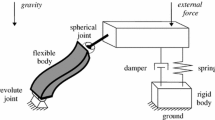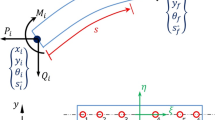Abstract
Purpose
The purpose of this paper is to study that which beam element should be adopted to achieve the required high accuracy and efficiency in different projects. Three kinds of beam elements commonly used to analyze the nonlinear dynamics of flexible multibody systems are compared and analyzed, which are fully parameterized beam and gradient-deficient beam elements based on the absolute nodal coordinate formulation, and geometrically exact beam element, respectively.
Methods
The governing equations are established based on the fully parameterized beam element, the gradient-deficient beam element and the geometrically exact beam element, and the generalized-α implicit time stepping algorithm is used to study the dynamic responses of system.
Results and Conclusion
In this study, the solution accuracy and efficiency of the three kinds of element are analyzed in both statics and dynamics in detail and compared with each other. It is found that the geometrically exact beam element is superior to other two elements when the discretized element is subjected to axial deformation and torsion. Both gradient-deficient beam element and geometrically exact beam element show the high accuracy and efficiency when the element is bent. Moreover, the Young’s modulus and time step have a great effect on displacement responses when the beam element is in dynamic state. All the results should be helpful for selection of a high-precision calculation method in engineering applications.









Similar content being viewed by others
References
Xu JG, Jia JG (2001) Study on dynamics, stability and control of multi-body flexible structure system in functional space. Appl Math Mech (English Edition) 22:1410–1421
Yong A, Huang ZC, Deng LX (2007) Dynamic analysis of a rotating rigid-flexible coupled smart structure with large deformations. Appl Math Mech (English Edition) 28:1349
Hu ZD, Hong JZ (1999) Modeling and analysis of a coupled rigid-flexible system. Appl Math Mech (English Edition) 20(10):1167–1174
Liu ZF, Yan SJ, Fu Z (2013) Dynamic analysis on generalized linear elastic body subjected to large scale rigid rotations. Appl Math Mech (English Edition) 34:1001–1016
Shabana AA (1996) An absolute nodal coordinates formulation for the large rotation and deformation analysis of flexible bodies. University of Illinois at Chicago, Chicago
Shabana AA (1997) Flexible multibody dynamics review of past and recent development. Multibody SysDyn 1:189–222
Schienlen W (2007) Research trends in multibody system dynamics. Multibody SysDyn 18:3–13
Escalona JL, Hussien HA, Shabana AA (1998) Application of the absolute nodal coordinate formulation to multibody system dynamic. J Sound Vib 214:833–951
Shabana AA, Yakoub RY (2001) Three-dimensional absolute nodal coordinate formulation for beam elements: theory. J Mech Design 123:606–613
Yakoub RY, Shabana AA (2001) Three-dimensional absolute nodal coordinate formulation for beam elements implementation and applications. J Mech Design 123:614–621
Berzeri M, Campanelli M, Shabana AA (2001) Definition of the elastic forces in the finite-element absolute nodal coordinate formulation and the floating frame of reference formulation. Multibody SysDyn 5:21–55
Gerstmayr J, Shabana AA (2006) Analysis of thin beams and cables using the absolute nodal coordinate formulation. Nonlinear Dyn 45:109–130
Schwarze M, Reese S (2010) A reduced integration solid shell finite element based on the EAS and the ANS concept-Large deformation problems. Int J Numer Meth Eng 85:289–329
Wu J, Zhao ZH, Ren GX (2012) Dynamic analysis of space structure deployment with transient thermal load. Adv Mater Res 479:803–807
Sopanen JT, Mikkola AM (2003) Description of elastic forces in absolute nodal coordinate formulation. Nonlinear Dyn 34:53–74
Omar MA, Shabana AA, Mikkola A (2004) Multibody system modeling of leaf springs. J Vib Control 10:1601–1638
Liu JY, Lu H (2007) Rigid-flexible coupling dynamics of a flexible beam with three-dimensional large overall motion. Multibody SysDyn 18:487–510
Liu J, Hong J, Cui L (2007) An exact nonlinear hybrid-coordinate formulation for flexible multibody systems. Acta Mech Sin 23:699–706
Liu JY, Lu H (2007) Rigid-flexible coupling dynamics of three-dimensional hub-beams system. Multibody SysDyn 18:487–510
Tian Q, Zhang YQ, Chen LP, Yang JZ (2010) Simulation of planar flexible multibody systems with clearance and lubricated revolute joints. Nonlinear Dyn 60:489–511
Tian Q, Zhang YQ, Chen LP (2009) Dynamics of spatial flexible multibody systems with clearance and lubricated spherical joints. Comput Struct 87:913–929
Tian Q, Chen LP, Zhang YQ (2009) An efficient hybrid method for multibody dynamics simulation based on absolute nodal coordinate formulation. J Comput Nonlinear Dyn 4:0210091
Liu C, Tian Q, Hu HY (2011) Dynamics of a large-scale rigid-flexible multibody system composed of composite laminated plates. Multibody SysDyn 26:283–305
Reissne E (1972) On one-dimensional finite-strain beam theory: the plane problem. Zeitschrift F Fur Angewandte Mathematik Und Physik 23:795–804
Simo JC, Vu-Quoc L (1988) On the Dynamics in space of rods undergoing large motions-a geometrically exact approach. Comput Methods Appl Mech Eng 66:125–161
Crisfield MA, Jelenic G (1999) Objectivity of strain measures in the geometrically exact three-dimensional beam theory and its finite-element implementation [J]. Proc Royal Soc Math Phys Eng Sci 455:1125–1147
Huang G, Zhong P, Yang G (2016) Frame-invariance in finite element formulations of geometrically exact rods. Appl Math Mech (English Edition) 37:12
Romero I (2008) A comparison of finite elements for nonlinear beams: the absolute nodal coordinate and geometrically exact formulations. Multibody SysDyn 20:51–68
Bauchau OA, Han S, Mikkola A (2014) Comparison of the absolute nodal coordinate and geometrically exact formulations for beams. Multibody SysDyn 32:67–85
Liu C (2013) Deployment dynamics of flexible space structures described by Absolute-Coordinate-Based Method [D]. Beijing Institute of Technology
Bonet J, Wood RD (2008) Nonlinear continuum mechanics for finite element analysis, 2nd edn. Cambridge University Press, New York
Jelenc G, Crisfield MA (1998) Interpolation of rotational variables in nonlinear dynamics of 3D beams. Int J Numer Meth Eng 43:1193–1222
Shabana AA (2005) Dynamics of multibody systems. Cambridge University Press, New York
Shabana A (2010) Computational dynamics, 3rd edn. Wiley, New York
Arnold M, Brüls O (2007) Convergence of the generalized-a scheme for constrained mechanical systems. Multibody SysDyn 18:185–202
Tian Q, Liu C, Machado M, Flores P (2011) A new model for dry and lubricated cylindrical joints with clearance in spatial flexible multibody systems. Nonlinear Dyn 64:25–67
Liu C, Tian Q, Hu H (2012) Dynamics and control of a spatial rigid–flexible multibody system with multiple cylindrical clearance joints. Mech Mach Theory 52:106–129
Timoshenko S, Gere J (1972) Mechanics of materials. Van Nostrand Reinhold Co., New York
Funding
This work is supported in part by the National Natural Science Foundation of China (Grant No.12102041; 52130512) and China Postdoctoral Science Foundation (Grant No. 2021M690401) and Graduate Technological Innovation Project of Beijing Institute of Technology (Project No. 2019CX10005).
Author information
Authors and Affiliations
Corresponding author
Ethics declarations
Conflict of interest
The authors declare no conflict of interest.
Additional information
Publisher's Note
Springer Nature remains neutral with regard to jurisdictional claims in published maps and institutional affiliations.
Rights and permissions
About this article
Cite this article
Wang, Z., Xiang, C., Liu, H. et al. Accuracy and Efficiency Analysis of the Beam Elements for Nonlinear Large Deformation. J. Vib. Eng. Technol. 11, 319–328 (2023). https://doi.org/10.1007/s42417-022-00581-1
Received:
Revised:
Accepted:
Published:
Issue Date:
DOI: https://doi.org/10.1007/s42417-022-00581-1
Keywords
- Fully parameterized beam element
- Gradient-deficient beam element
- Geometrically exact beam element
- Accuracy
- Nonlinear large deformation




